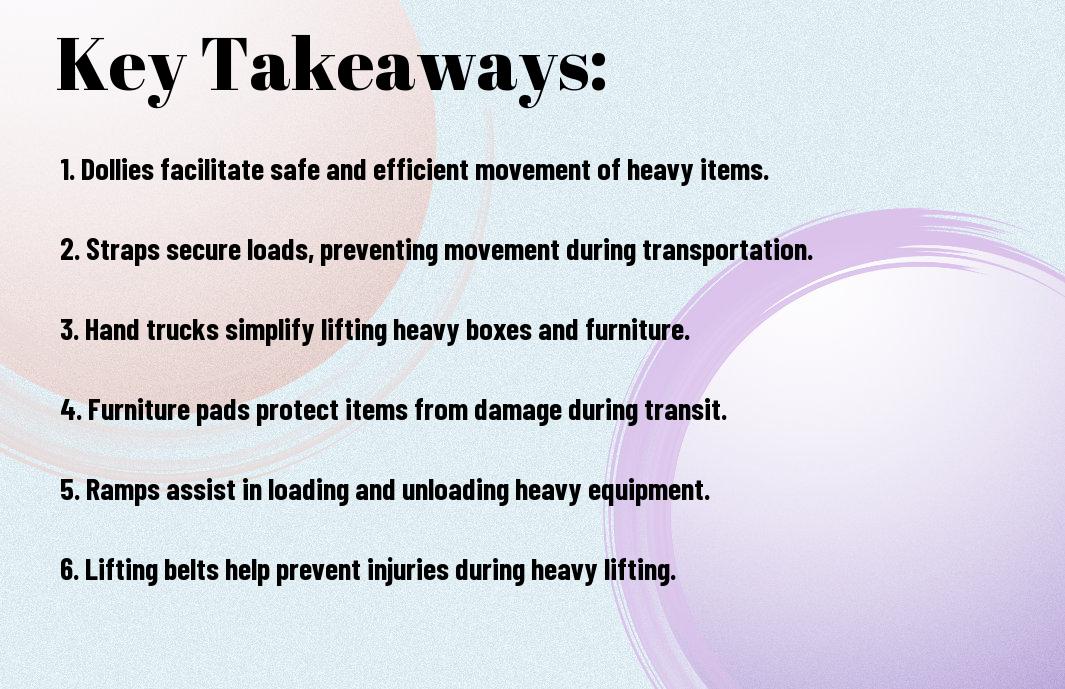Just as you would not attempt to lift a heavy sofa without the right tools, professional movers rely on necessary equipment for heavy lifting. Understanding the tools they use can help you appreciate the importance of proper technique and equipment in ensuring a smooth move. In this blog post, you will discover the various types of equipment movers use, from dollies to forklifts, and how each plays a vital role in making your relocation as efficient and safe as possible.
Key Takeaways:
- Movers rely on equipment such as dollies, hand trucks, and furniture sliders to safely transport heavy items with ease and minimize the risk of injury.
- Moving straps and harnesses are used to secure and distribute the weight of large, bulky items, making it easier for movers to lift and carry them collaboratively.
- Heavy-duty packing materials, including blankets and bubble wrap, provide protection for both the items being moved and the movers, preventing damage during transit.
Types of Essential Equipment
Your move can be greatly facilitated by understanding the vital equipment used by movers. The right tools ensure safety and efficiency, allowing for a smoother experience. Key pieces of equipment include:
| Dollies | For moving heavy items easily |
| Hand Trucks | Ideal for transporting boxes and appliances |
| Lifting Straps | For optimizing lifting technique |
| Furniture Blankets | To protect your belongings during transport |
| Hoisting Equipment | For moving heavy items to higher locations |
Recognizing the importance of these tools will empower you during your moving process.
Dollies and Hand Trucks
Across the moving industry, dollies and hand trucks play an vital role. These tools significantly reduce the physical effort required to lift and transport heavy items. You can maneuver them easily, making the moving process more efficient. With their sturdy construction, they are designed to handle various weights, providing support and stability during transport.
Lifting Straps and Slings
Types of lifting straps and slings vary based on their intended use. They enable you and your team to carry heavier loads with minimal strain. These harness-like devices distribute weight evenly, improving posture and reducing the risk of injury during the lifting process.
And using lifting straps can unlock your team’s lifting potential, ultimately leading to better productivity. They allow for a collaborative approach, maximizing strength while minimizing individual effort. By implementing lifting straps, you can ensure safety and efficiency, vital components of a successful move.
Furniture Blankets and Pads
Above all, furniture blankets and pads are vital for safeguarding your belongings. These protective covers prevent scratches, dents, and other types of damage during transport. You will find that using high-quality blankets can help keep your furniture in pristine condition throughout the moving process.
Equipment like furniture blankets effectively cushions your items, making it easier to move them without worry. They cling well to different furniture shapes, ensuring complete coverage. This additional layer of protection can significantly reduce the risk of damage, allowing for peace of mind as you transition to your new space.
Hoisting Equipment
By incorporating hoisting equipment into your moving strategy, you can manage heavy items with greater ease. Hoisting tools allow you to lift objects up to higher levels or even over obstacles seamlessly. You will find that this equipment is especially useful in tight spaces or when navigating stairs.
In addition to efficiency, hoisting equipment enhances safety for everyone involved. It minimizes the risk of injury that can occur from manual lifting and gives you the ability to handle heavier loads effectively. Investing in the right hoisting equipment can transform a potentially cumbersome process into a swift, streamlined task.
Safety Gear for Movers
Assuming you are preparing for a move, being equipped with the right safety gear is imperative for protecting yourself during heavy lifting tasks. Proper safety gear minimizes the risk of injury and helps ensure a smoother moving process. You’ll want to invest in quality equipment designed for durability and comfort as you handle various items throughout your relocation.
Gloves and Safety Shoes
Along with a sturdy moving strategy, wearing gloves and safety shoes is paramount in creating a safe environment for yourself. Gloves provide grip and protect your hands from cuts and abrasions, while safety shoes offer cushioning, support, and protection against objects that may fall or roll during lifting and transport.
Hard Hats and Protective Eyewear
One important aspect of safety gear is the use of hard hats and protective eyewear, especially when navigating cluttered areas or handling large items. These two pieces of equipment shield you from falling debris and protect your vision from dust and other particles that may arise during the moving process.
To ensure maximum protection, choose hard hats that meet safety standards and fit securely on your head. Protective eyewear should be comfortable and provide a clear line of sight while guarding against potential hazards. Investing in high-quality safety gear gives you peace of mind, allowing you to focus on the task at hand without worrying about potential injuries.
Load Securing Tools
Despite the robust nature of heavy lifting equipment, securing loads during transport is equally vital. Load securing tools ensure that your belongings stay in place, minimizing the risk of damage and accidents on the road. By using the right tools, you can transport heavy items confidently while maintaining safety standards.
Ratchet Straps
Below, you’ll find ratchet straps proven effective for securing heavy loads. Their ratcheting mechanism allows you to tighten the strap to your preferred tension, ensuring your items do not shift during transit. Easily adjustable, these straps can accommodate various load sizes and types, making them a go-to choice for efficient moving.
Cargo Nets
Load securing tools also include cargo nets, which provide excellent coverage for larger items. These nets distribute weight evenly and help to keep items from shifting, providing an added layer of security during transit. They are particularly useful for transporting irregularly shaped or bulky items where standard tie-downs may not suffice.
Indeed, cargo nets can be invaluable in your moving arsenal, as they offer flexibility and adaptability for different types of loads. When securing larger items, the mesh design allows for airflow, preventing moisture buildup that can cause damage. Additionally, they are generally lightweight and easy to handle, making them an efficient option for your moving needs.
Vehicle Equipment
Keep in mind that the right vehicle equipment is necessary for efficient moving operations. Heavy lifting requires specialized vehicles designed to transport bulky items while ensuring their safety during transit. Investing in quality vehicle equipment not only enhances productivity but also protects your belongings, making your moving process much smoother.
Moving Trucks
Along with vehicle equipment, moving trucks play a vital role in your heavy lifting capabilities. These trucks are designed to accommodate a wide range of sizes and weights, allowing you to transport various items in a single trip. When choosing a moving truck, consider the truck’s load capacity, size, and how it fits your specific moving needs.
Lift Gates
Along with moving trucks, lift gates are necessary for easily loading and unloading heavy items. These hydraulic platforms can be lowered to the ground, making it simple for you to maneuver large furniture or equipment into and out of your truck. They significantly reduce the physical strain on your body while ensuring the safety of your items throughout the moving process.
Moving with lift gates not only saves you effort but also minimizes the risk of injury and damages. By providing a seamless transition between the ground and the truck’s cargo area, lift gates streamline the loading process. This equipment is particularly useful in tight spaces where ramps may not be feasible, allowing you to move heavier items quickly and efficiently.
Tools for Disassembly and Assembly
Not every item can be easily moved as is, which is why having the right tools for disassembly and assembly is necessary for your moving process. These tools enable you to effectively break down larger furniture and reassemble it at your new location. For additional insights, you can check out 11 Essential Moving Supplies and Equipment: The Ultimate List.
Basic Hand Tools
To ensure your move goes smoothly, you should have a selection of basic hand tools such as screwdrivers, wrenches, and hammers on hand. These tools are useful for quickly disassembling and assembling furniture pieces, making them easier to transport without damage.
Power Tools
Besides hand tools, power tools can significantly speed up the disassembly process. Tools like power drills and saws enable you to tackle tougher jobs efficiently, especially when working with large, heavy items. These tools are ideal for those quick fixes and adjustments that may come up during your move.
Indeed, using power tools not only enhances your efficiency but also reduces physical strain when dealing with heavy furniture. They allow you to make precise cuts and fastenings, saving time while ensuring your belongings are properly secured during transport. This means you’re less likely to encounter difficulties when reassembling your items in your new home.
Tips for Effective Heavy Lifting
After understanding the equipment, it’s important to implement effective strategies for heavy lifting. Follow these tips for a successful move:
- Plan your route and ensure it is clear of obstacles.
- Use proper lifting techniques to prevent injury.
- Secure a good grip on the item before lifting.
- Take breaks as needed to avoid fatigue.
- Stay hydrated throughout the process.
Recognizing the importance of these tips will make your heavy lifting experience much safer and more efficient.
Proper Lifting Techniques
After you decide to lift an item, use the right techniques to protect your back and avoid injury. Stand close to the object with your feet shoulder-width apart. Bend at your knees, not your waist, and keep your back straight. Grip the item firmly, engaging your core muscles, and lift by straightening your legs, not your back. Always lift smoothly, not with jerky movements, to avoid strain. This method will help you lift heavy items safely and effectively.
Team Coordination and Communication
Lifting heavy items alone can lead to mishaps, which is why team coordination and communication are vital. Engage with your team members to establish a clear plan before lifting any heavy objects. Discuss how you will maneuver the item and designate a lead to call out commands during the lift.
Hence, working collaboratively ensures that everyone is on the same page, minimizing the risk of accidents. Clear communication helps in aligning movements, preventing missteps that could cause injuries or damage. Assigning specific roles and maintaining eye contact during the lift will significantly enhance your effectiveness as a team.
Conclusion
With this in mind, equipping yourself with the right moving company equipment for heavy lifting will significantly improve your efficiency and safety during moves. Tools such as furniture dollies, moving straps, hand trucks, and ramps not only ease the physical strain but also help protect your valuable items. By investing in quality equipment tailored for heavy lifting, you can ensure a smoother, more organized moving process for you and your clients, ultimately enhancing your reputation in the moving industry.
FAQ
Q: What equipment do movers typically use for lifting heavy furniture?
A: Movers often use a variety of specialized equipment to safely lift and transport heavy furniture. Common tools include hand trucks, which allow for easier maneuvering of items, and furniture dollies, which provide a stable platform for moving large pieces without damaging flooring. Additionally, appliance lifts are used for particularly heavy appliances, allowing movers to lift items vertically with reduced risk of injury.
Q: Are there specific safety tools that movers use for heavy lifting?
A: Yes, safety is a priority for movers when handling heavy items. Many use lifting straps or harnesses, which help distribute weight evenly and reduce strain on the body. Back supports or weight belts are sometimes worn to help prevent injuries during lifting. Additionally, movers may use gloves with good grip to improve control over the items being moved, minimizing the risk of slips and drops.
Q: How do movers prepare for lifting heavy items without injury?
A: Movers follow specific best practices and techniques to lift heavy items safely. They typically assess the weight and dimensions of the items before attempting to lift them. Proper lifting techniques, such as bending at the knees and keeping the back straight, are emphasized. Movers may also collaborate with each other to lift heavy items as a team, ensuring that the burden is shared and reducing the likelihood of accidents.






